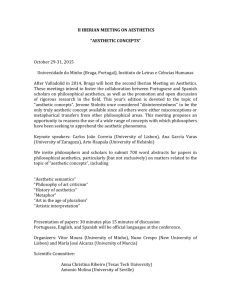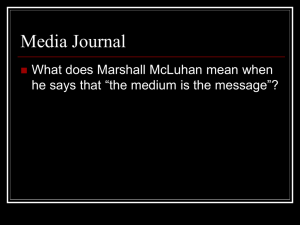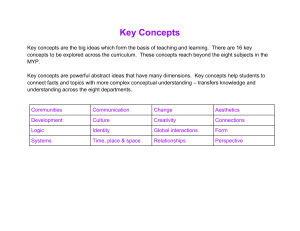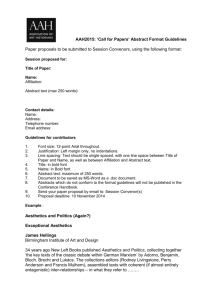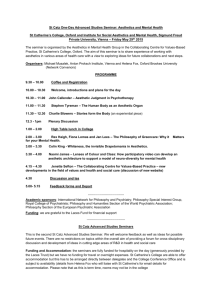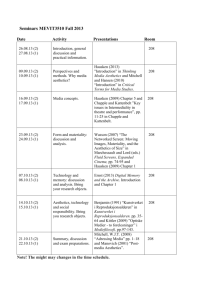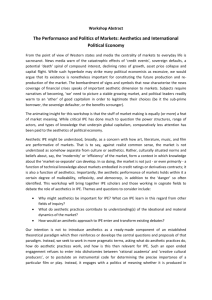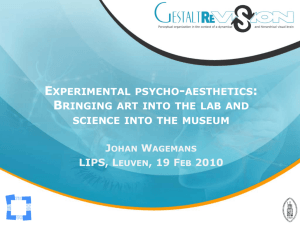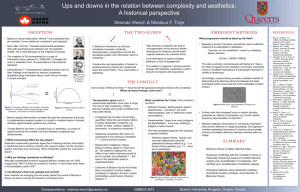Decoding Websites: From aesthetics to meaning
advertisement
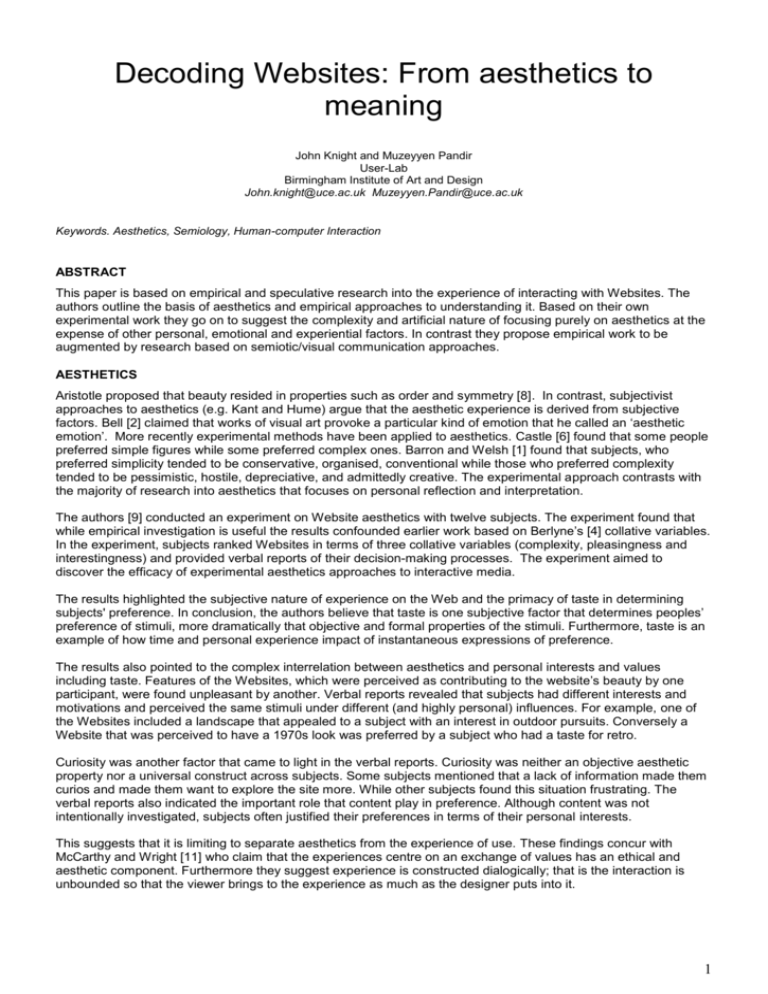
Decoding Websites: From aesthetics to meaning John Knight and Muzeyyen Pandir User-Lab Birmingham Institute of Art and Design John.knight@uce.ac.uk Muzeyyen.Pandir@uce.ac.uk Keywords. Aesthetics, Semiology, Human-computer Interaction ABSTRACT This paper is based on empirical and speculative research into the experience of interacting with Websites. The authors outline the basis of aesthetics and empirical approaches to understanding it. Based on their own experimental work they go on to suggest the complexity and artificial nature of focusing purely on aesthetics at the expense of other personal, emotional and experiential factors. In contrast they propose empirical work to be augmented by research based on semiotic/visual communication approaches. AESTHETICS Aristotle proposed that beauty resided in properties such as order and symmetry [8]. In contrast, subjectivist approaches to aesthetics (e.g. Kant and Hume) argue that the aesthetic experience is derived from subjective factors. Bell [2] claimed that works of visual art provoke a particular kind of emotion that he called an ‘aesthetic emotion’. More recently experimental methods have been applied to aesthetics. Castle [6] found that some people preferred simple figures while some preferred complex ones. Barron and Welsh [1] found that subjects, who preferred simplicity tended to be conservative, organised, conventional while those who preferred complexity tended to be pessimistic, hostile, depreciative, and admittedly creative. The experimental approach contrasts with the majority of research into aesthetics that focuses on personal reflection and interpretation. The authors [9] conducted an experiment on Website aesthetics with twelve subjects. The experiment found that while empirical investigation is useful the results confounded earlier work based on Berlyne’s [4] collative variables. In the experiment, subjects ranked Websites in terms of three collative variables (complexity, pleasingness and interestingness) and provided verbal reports of their decision-making processes. The experiment aimed to discover the efficacy of experimental aesthetics approaches to interactive media. The results highlighted the subjective nature of experience on the Web and the primacy of taste in determining subjects' preference. In conclusion, the authors believe that taste is one subjective factor that determines peoples’ preference of stimuli, more dramatically that objective and formal properties of the stimuli. Furthermore, taste is an example of how time and personal experience impact of instantaneous expressions of preference. The results also pointed to the complex interrelation between aesthetics and personal interests and values including taste. Features of the Websites, which were perceived as contributing to the website’s beauty by one participant, were found unpleasant by another. Verbal reports revealed that subjects had different interests and motivations and perceived the same stimuli under different (and highly personal) influences. For example, one of the Websites included a landscape that appealed to a subject with an interest in outdoor pursuits. Conversely a Website that was perceived to have a 1970s look was preferred by a subject who had a taste for retro. Curiosity was another factor that came to light in the verbal reports. Curiosity was neither an objective aesthetic property nor a universal construct across subjects. Some subjects mentioned that a lack of information made them curios and made them want to explore the site more. While other subjects found this situation frustrating. The verbal reports also indicated the important role that content play in preference. Although content was not intentionally investigated, subjects often justified their preferences in terms of their personal interests. This suggests that it is limiting to separate aesthetics from the experience of use. These findings concur with McCarthy and Wright [11] who claim that the experiences centre on an exchange of values has an ethical and aesthetic component. Furthermore they suggest experience is constructed dialogically; that is the interaction is unbounded so that the viewer brings to the experience as much as the designer puts into it. 1 MEANING Martindale et al [10] found that semantic factors were more important than the collative variables in aesthetic preference. In our study, some subjects mentioned this role of semantics in preference. For example, one website featuring a ring was found visually appealing, but because its message was perceived as suggesting weddings, it was considered boring by one subject. This finding also supports the proposed link between preference and individual differences. Weddings may be boring to some people, but it can be something to dream about for others. While aesthetics is a useful paradigm for understanding the user experience the authors consider that meaning has to be investigated in other ways. Thus current research is investigating the possibility of combining empirical research into taste and aesthetic judgements with semiological approaches to investigating meaning. Rather than dealing with preference this investigation aims to understand the characteristics of the Web as a medium. Early research indicates that achieving this requires augmenting semiology with visual research methods. Semiology and semiotics are science of signs. Signs represent and communicate meanings and can be read and decoded. Signs are the components of language and translate concepts in our minds into the physical world [7]. Berger [3] notes that transmitting meanings is a complex language that uses signs in different ways including association (metonymy) and analogy (metaphor). However, research suggests that, at least for Websites, the language paradigm is limiting and requires investigation of factors studied in visual communication theory. This chimes with our own research pointing to the personal and emotional aspects of 'aesthetic' experience. Dondis [5] proposes the search of the meaning involves the following: “In all visual stimuli, on all levels of visual intelligence, meaning may lie not only in the representational data, the environmental information, in the symbols including language, but also in the compositional forces that exist or coexist with the factual, visual statement. Any visual event is a form with content, but the content is highly influenced by the significance of the constituent parts, such as color [sic], tone, texture, dimension, proportion, and their compositional relationships to meaning” (Ibid:015). VISUAL COMMUNICATION Reading web sites needs to address the meanings of the representational data, the components of the composition and their contributions to the meanings. Rose [12] proposes compositional interpretation as an approach to describe how an image is organised. There are two types of elements of visual composition; basic components and visual techniques. All basic components have their own characteristics and the way they are combined expresses the intentional or indeed unintentional meaning that the designer wishes to communicate. Rose [12] categorises five components consisting of content, colour, spatial organization, light and expressive content. Visual techniques add to the emotional charge and effect the message. Dondis (1973) suggests contrast as the most important technique, thus each technique has its opposite to create various effects. For example, expression of feelings such as trustworthiness and reliability require balance, symmetry, regularity and unity. Dondis lists some of the visual techniques and their opposites: balance-instability symmetry-asymmetry regularity-irregularity unity-fragmentation economy-intricacy understatement-exaggeration predictability-spontaneity activeness-passiveness subtlety-boldness neutrality-accent transparency-opacity consistency-variation realism-distortion flatness-depth singularity-juxtaposition sequentiality-randomness sharpness-diffusion continuity-episodicity Another important factor that affects the image and the message are the context and the medium. The context, in which the images are found, determines the meanings of ambiguous images. Context plays an important role in ensuring comprehension. In the context of film, violent images are predicated on the assumption that they are not real because if they were real they would break the convention of the genre. It is clear that context impacts on the Web through both the context of use as well as genre. CONCLUSION 2 Web sites that communicate meanings, ideas and feelings are also signs. A web site is a group of communicative signs. Each sign has an individual meaning and function that includes aesthetics but also more instrumental factors such as meaning. The authors propose an approach involving semiology and visual language components to read web sites. Rather than measuring, the authors aim to interpret. Some of the visuals on web sites are intended to convey denotative meanings only. In this respect, the aim of bringing together semiology and the Web is to define the best graphical figures we should use according to the atmosphere of the home page, to find the right language according to the target we want to reach, to create the most effective labelling or the best relation between the sender and the web surfer in order to achieve its communicative aims. At another level, this investigation ought to ground Web aesthetics in a wider discipline of empiricism and interpretation. REFERENCES 1. Barron, F. and Welsh, G. S. (1952) “Artistic perception as a possible factor in personality style: Its measurement by a figure preference test" The Journal of Psychology, Vol. 33. 199-203. 2. Bell, C. (1997) “The Aesthetic Hypothesis” in S. Feagin and P. Maynard, ed. Oxford Readers – Aesthetics. Oxford: Oxford University Press 3. Berger, A. A (1998). Seeing is believing: An Introduction To Visual Communication. Mayfield Publishing Company. Mountain View, California. ISBN1-55934-909-3 4. Berlyne, D. E. (1974) Studies in the New Experimental Aesthetics – Steps toward an Objective Psychology of Aesthetic Appreciation. (ed.) Hemisphere Publishing 5. Dondis, D. A. (1973) A Primer of Visual Literacy London: MIT Press 6. Eysenck, H.J. and Castle, M. (1970) “Training in art as a factor in the determination of preference judgements for polygons” British Journal of Psychology. Vol. 61, No.1. 65-81. 7. Hall, S. (1997) “The work of representation” in S. Hall (ed.) Representation: Cultural Representations and Signifying Practices. Sage 8. Hanfling, O. (1992) “Aesthetic Qualities” in O. Hanfling, ed. Philosophical Aesthetics: An Introduction. Oxford: Blackwell Publishers. 9. Knight, J. and Pandir, M. (2004). An Experimental Aesthetics Approach to Evaluating Websites. In: Proceedings of Aesthetic Approaches to Human-Computer Interaction Workshop Nordichi 2004, Tampere University, 23-27th October. 23-27th University of Aarhus. ISSN 0105-8515 10. Martindale, C. Moore, K. and Borkum, J. (1990) “Aesthetic Preference: Anomalous Findings for Berlyne’s Psychobiological Theory”. American Journal of Psychology. Vol 103, no 1, pp. 53-80 11. McCarthy, J and Wright, P.(2004). Technology as Experience. MIT Press, Cambridge Massachusetts. ISBN0-262-13447-0 12. Rose, G. (2001). Visual methodologies: an introduction to the interpretation of visual materials. Sage, London. ISBN: 076196665X 3
